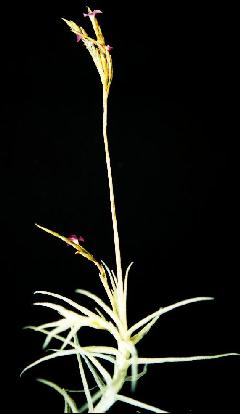
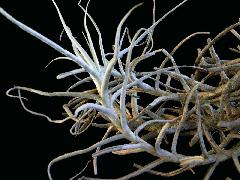
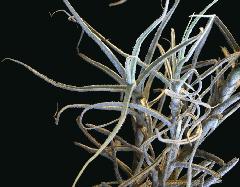
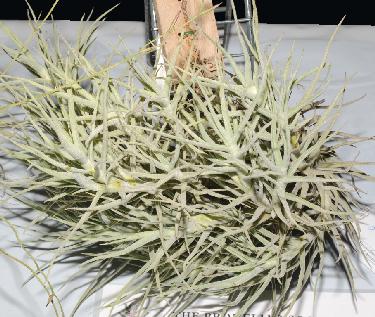
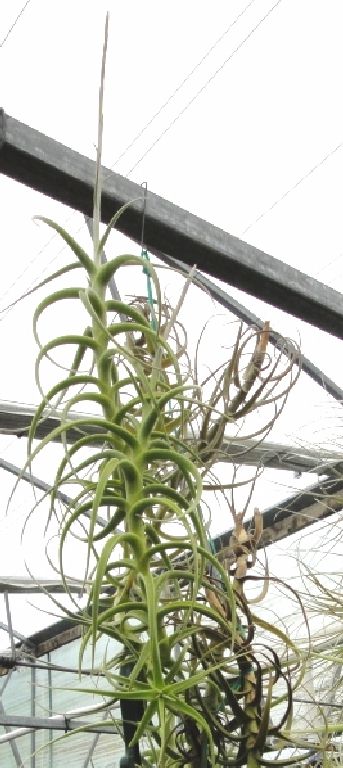
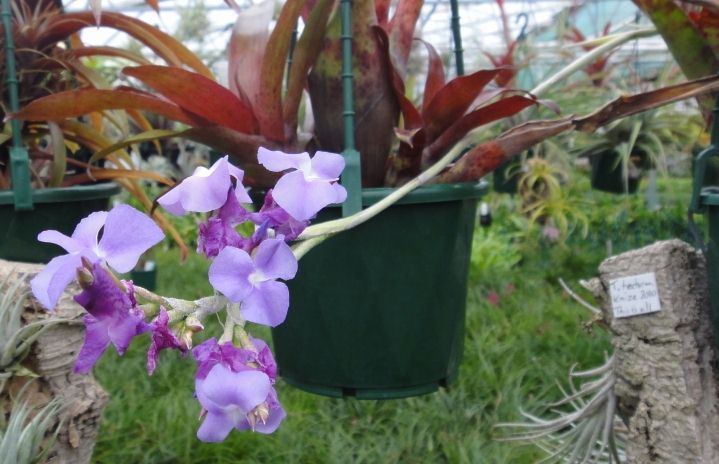
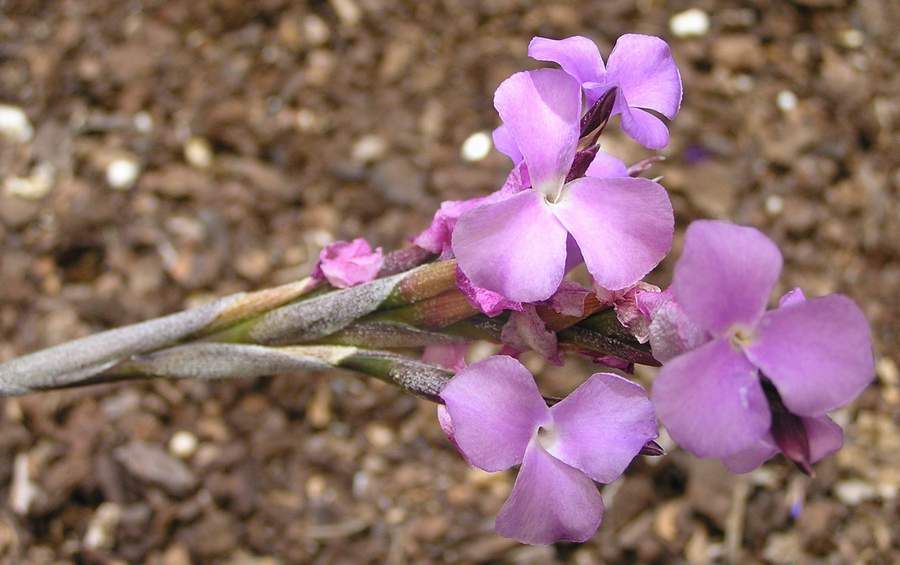
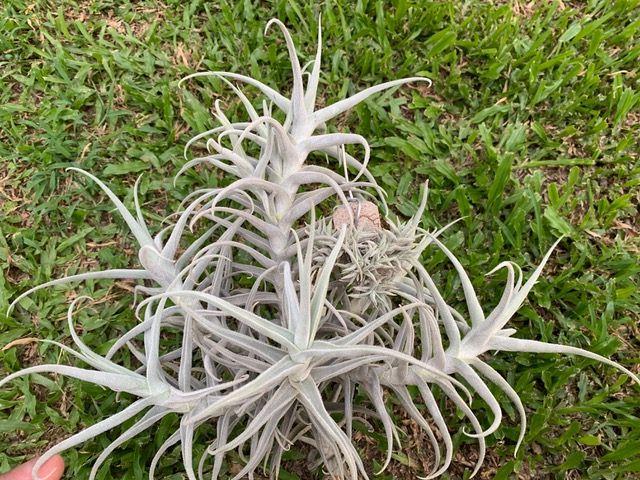
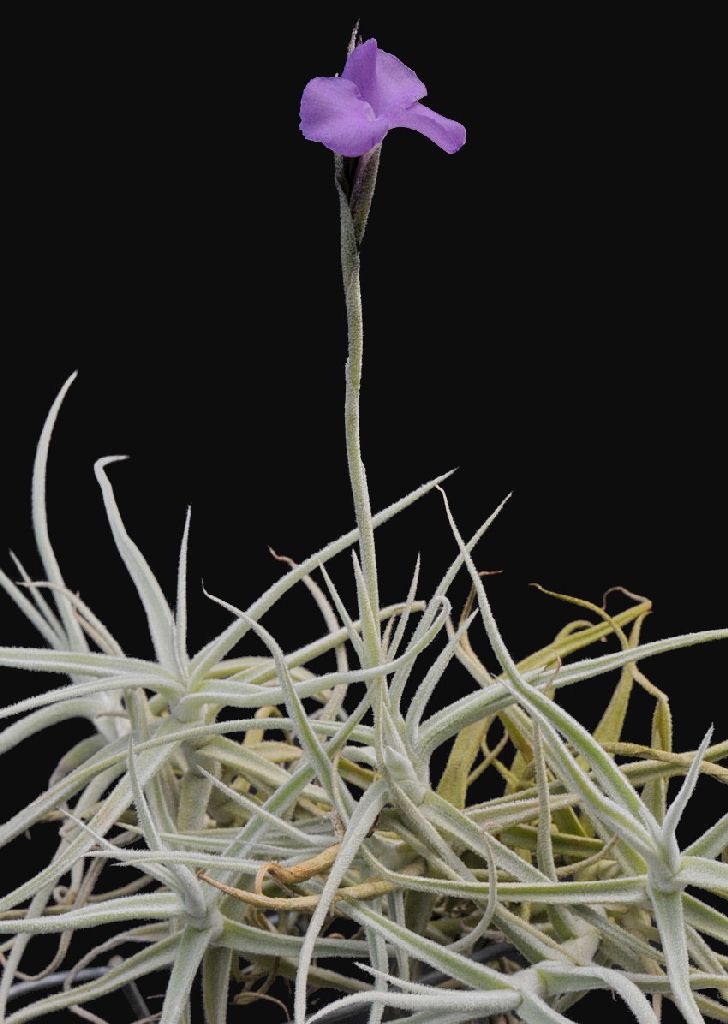
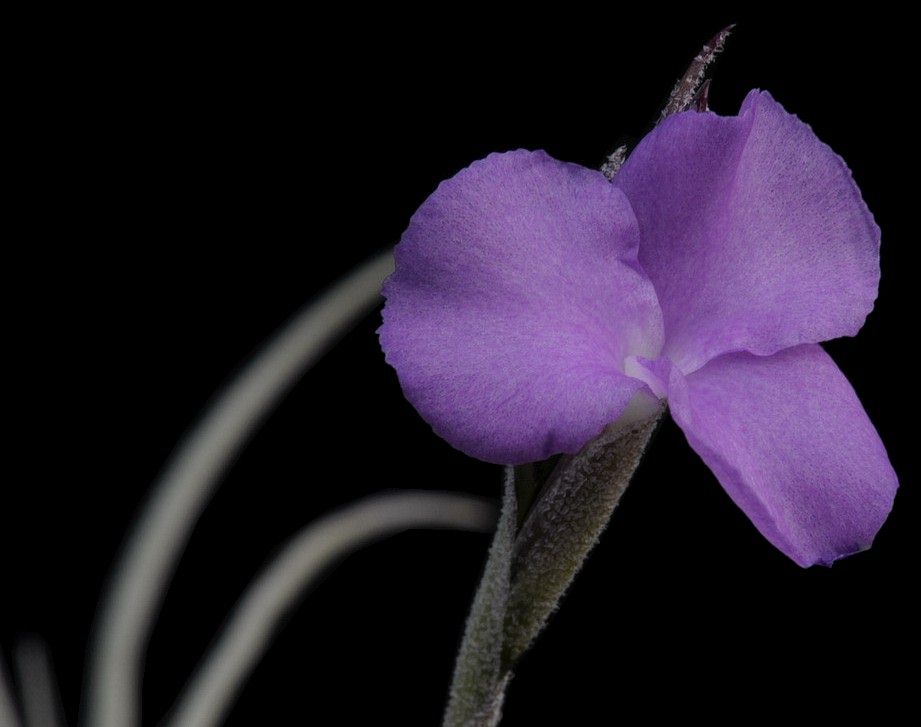
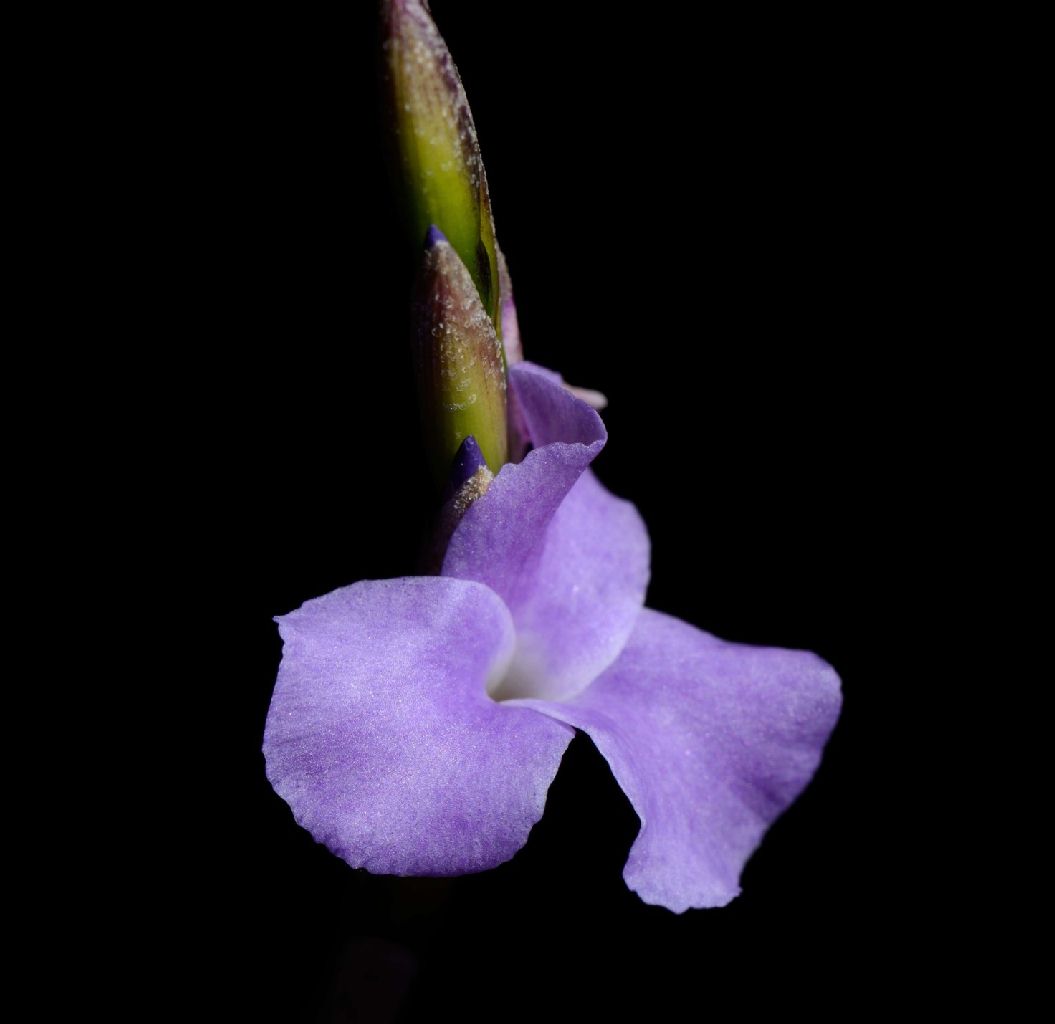
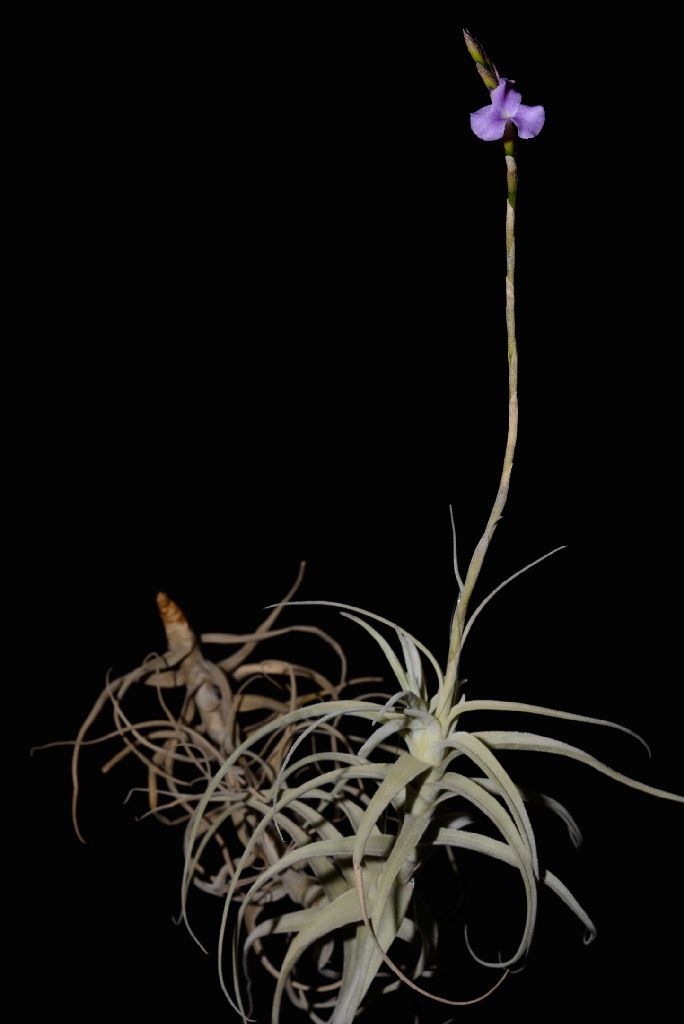
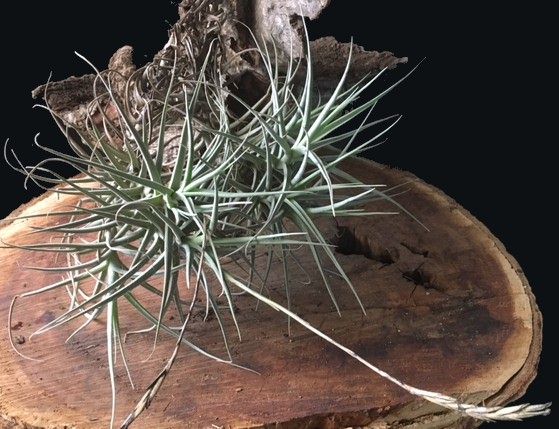
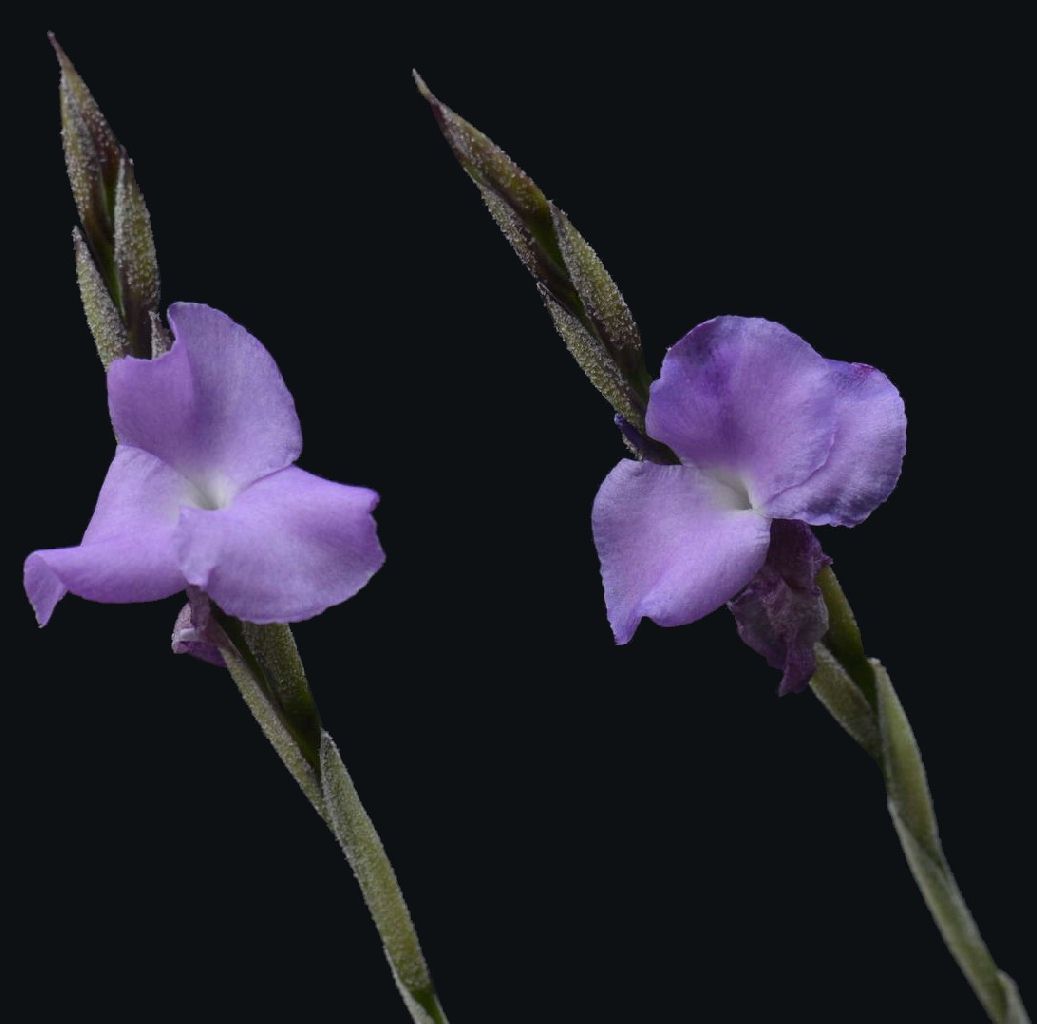
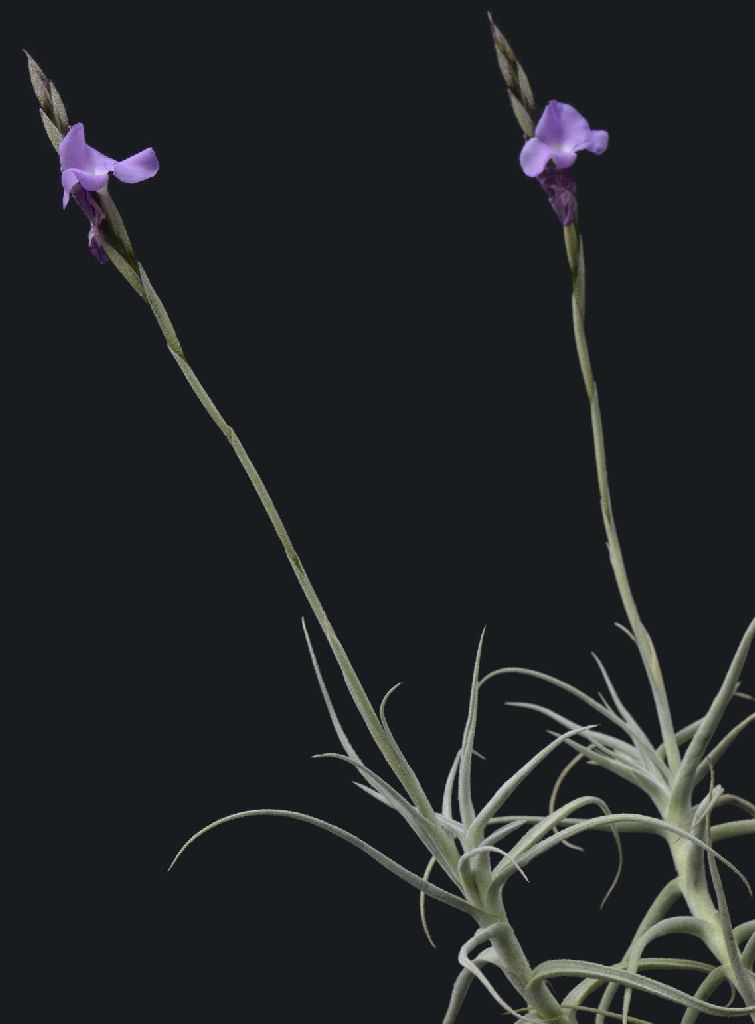
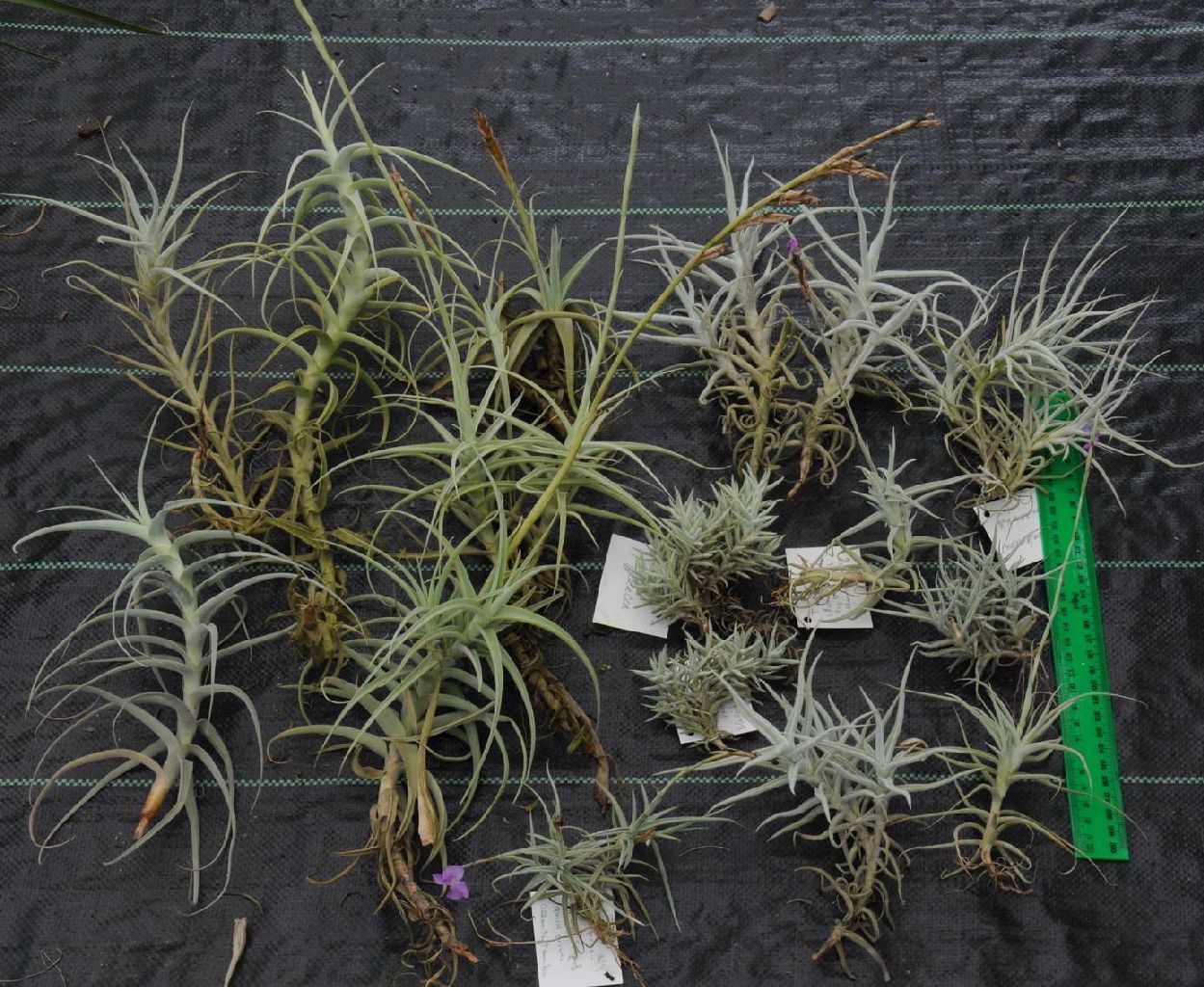
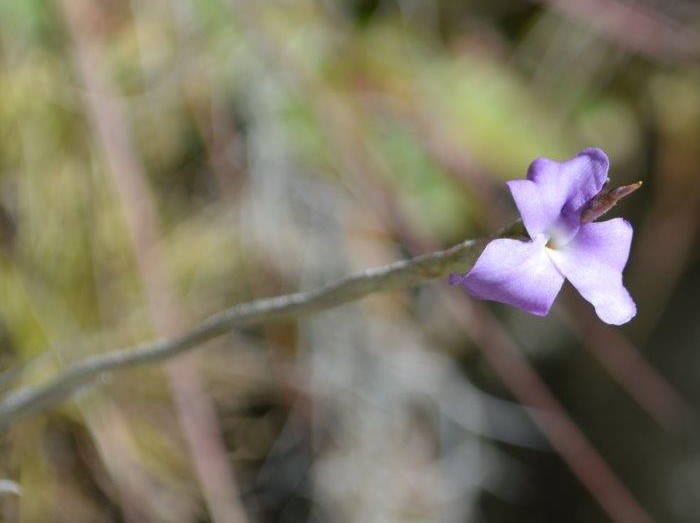
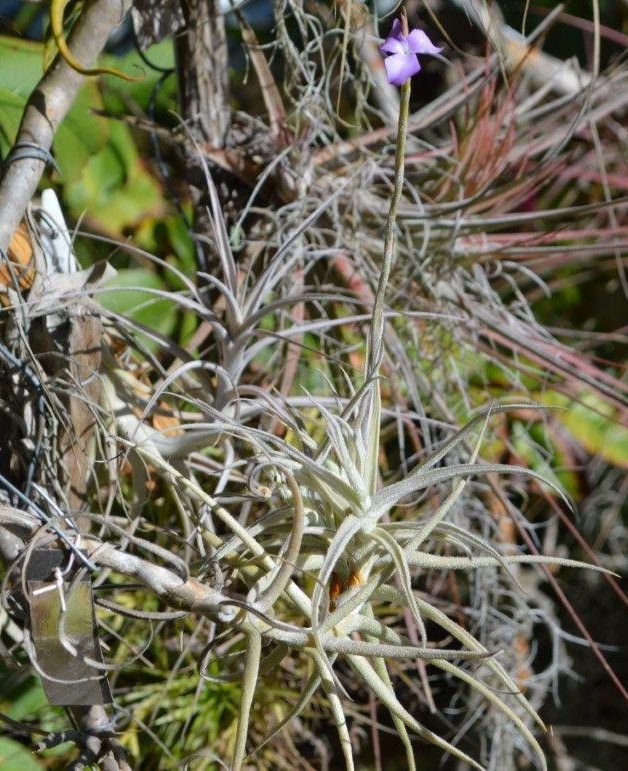
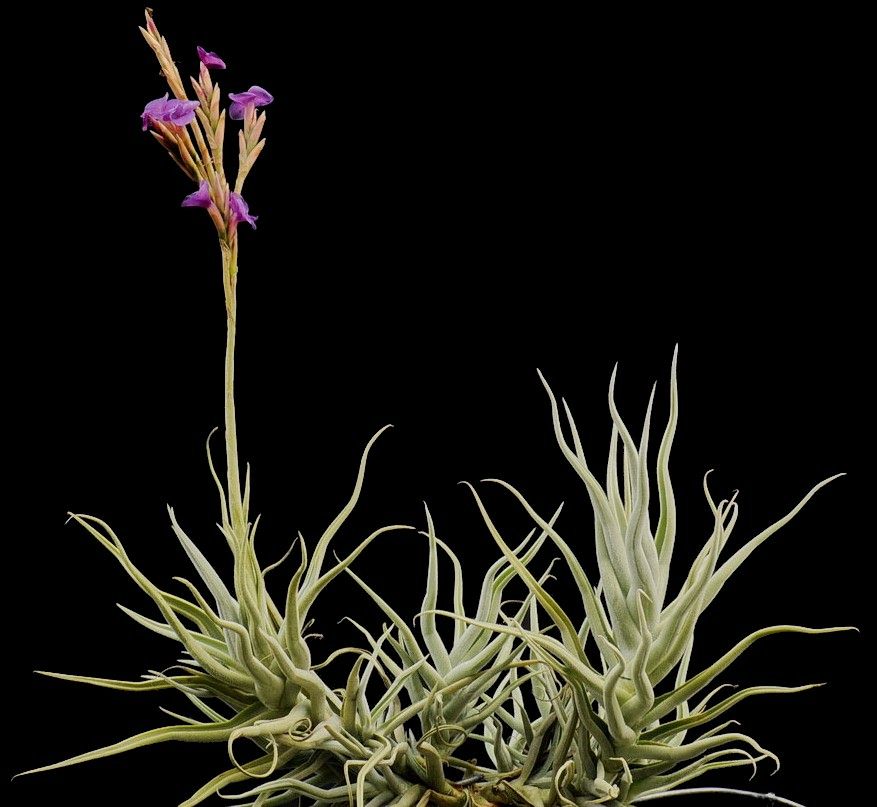
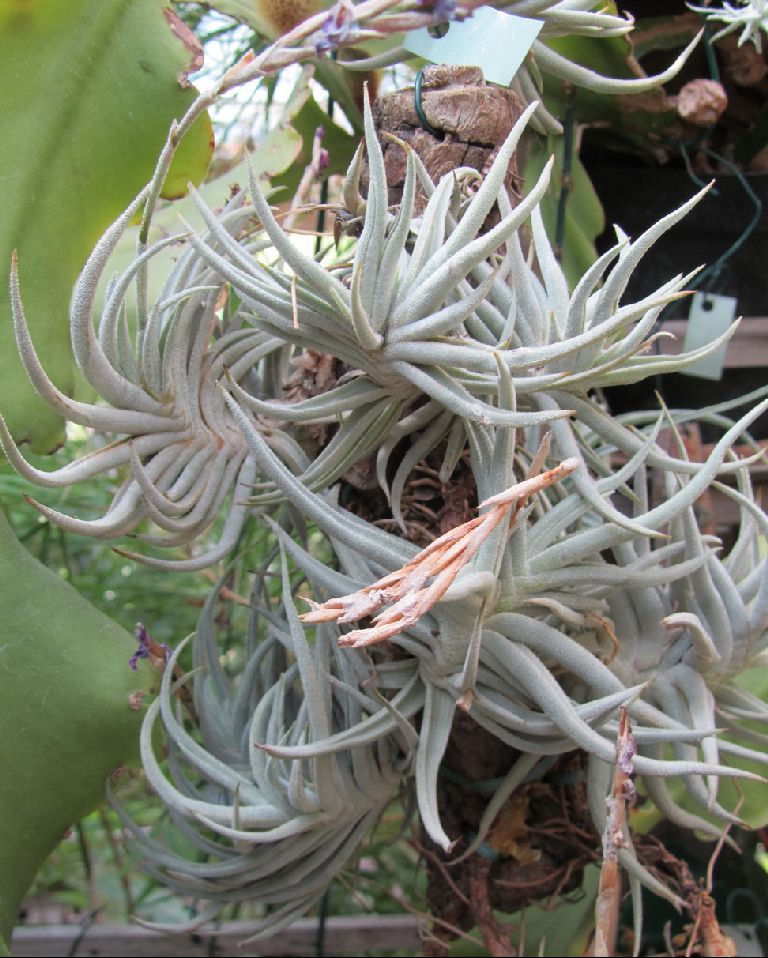
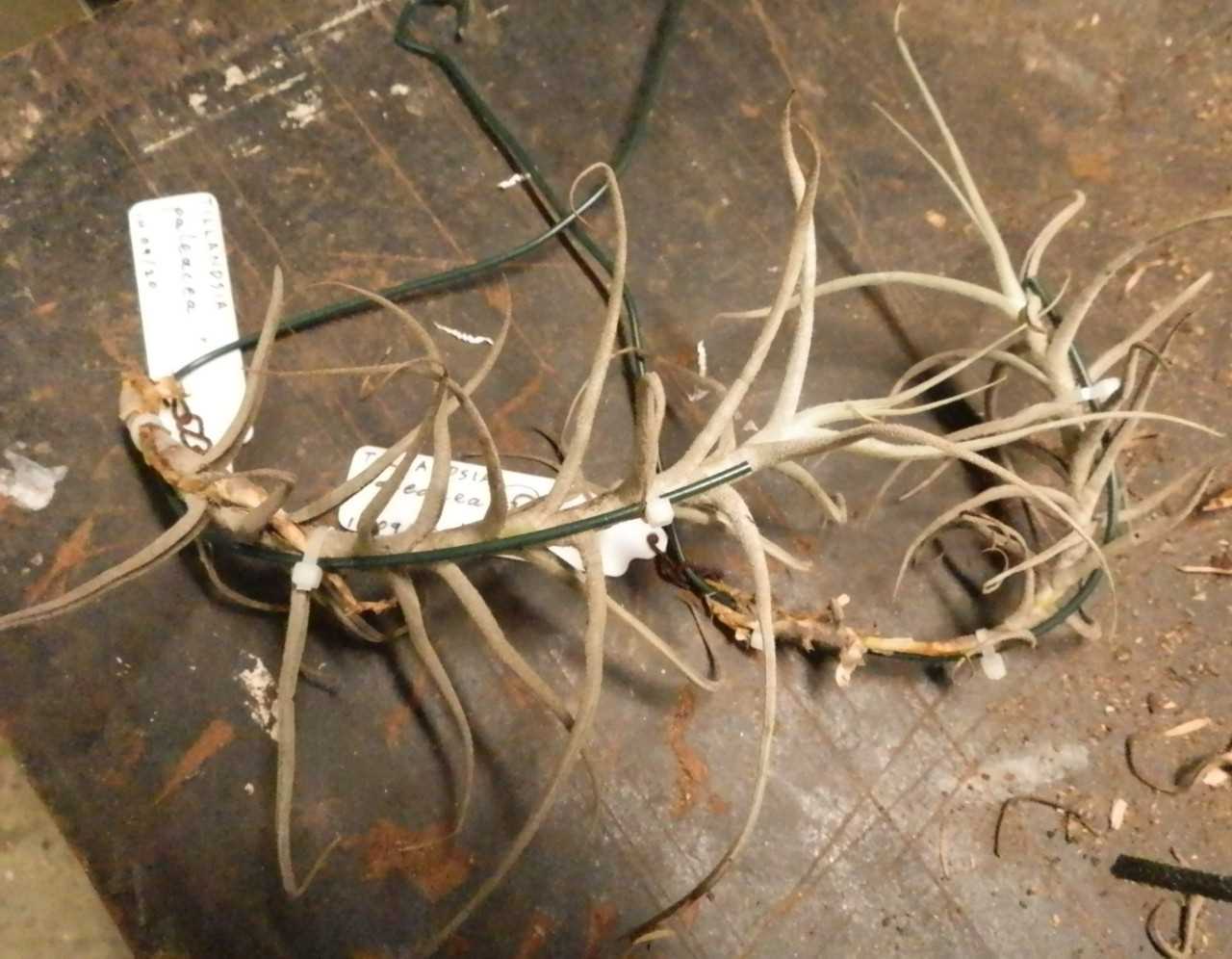
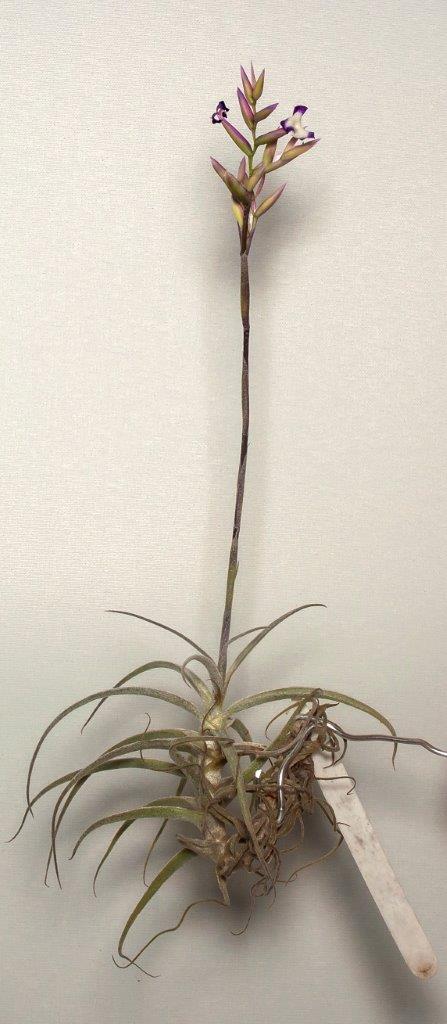
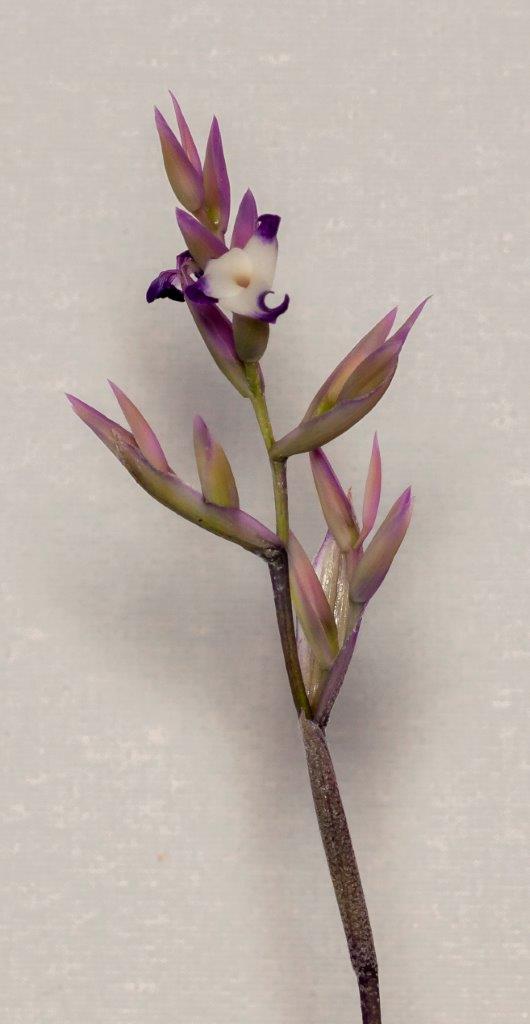
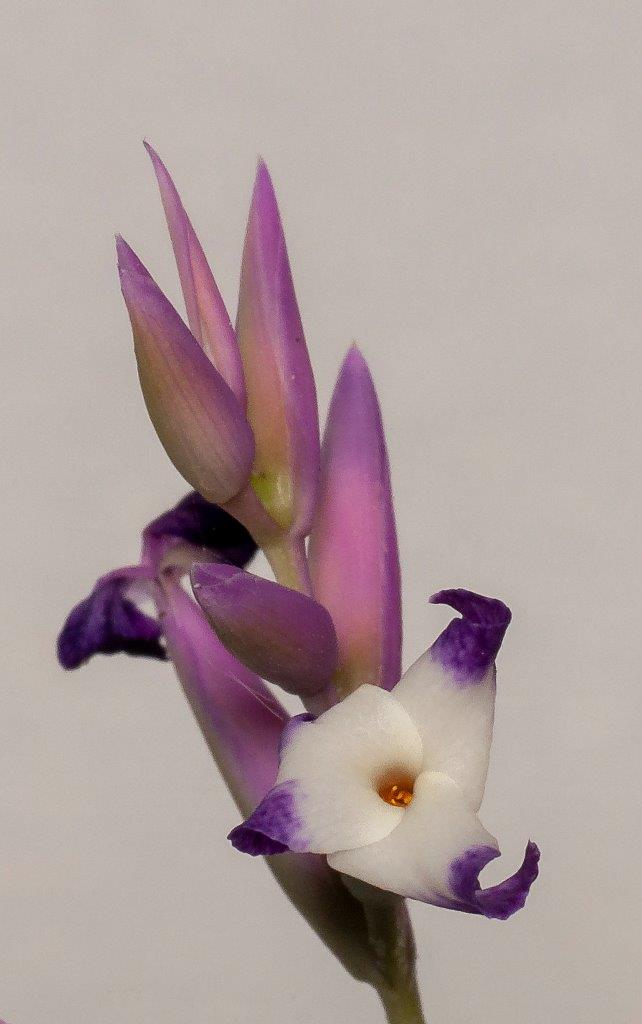
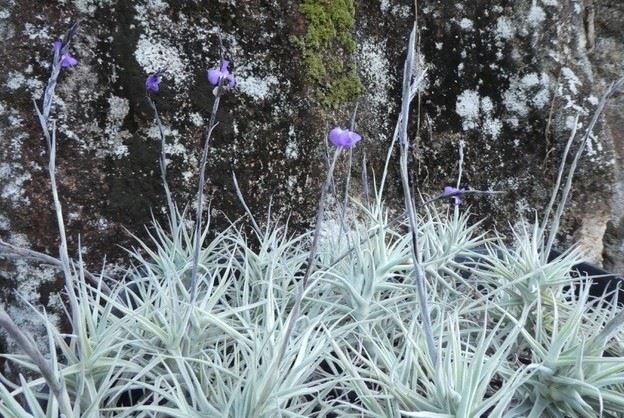
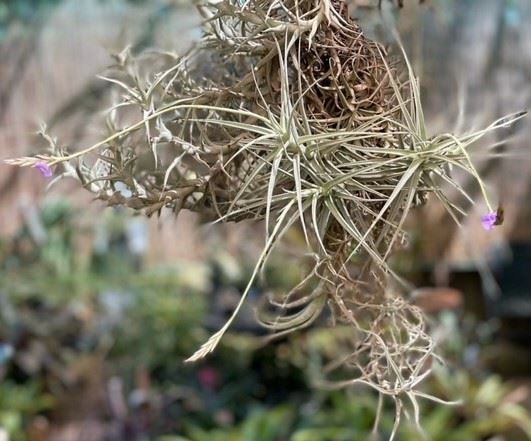
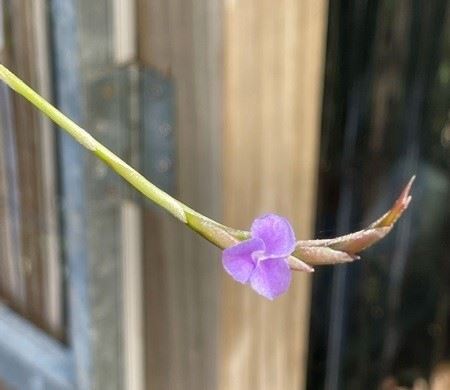
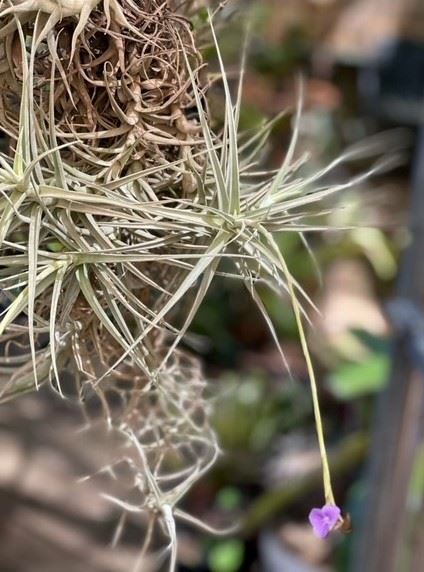
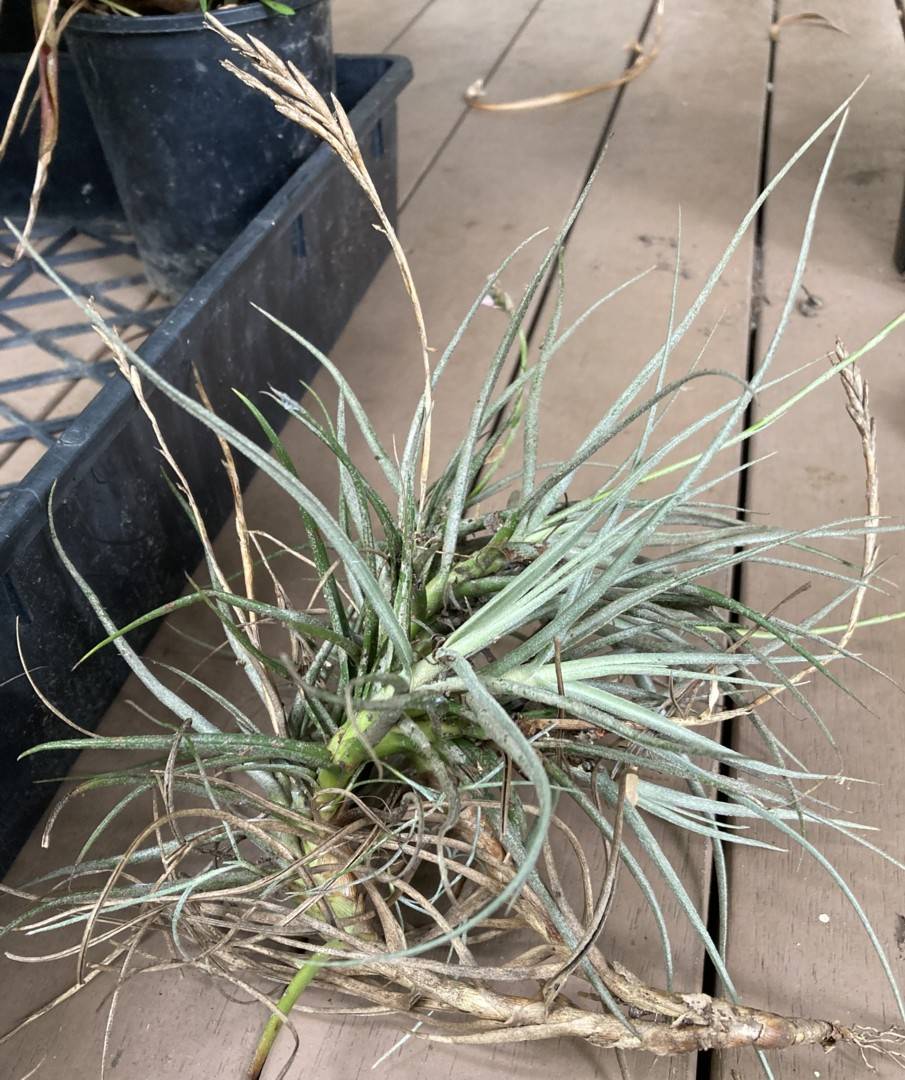
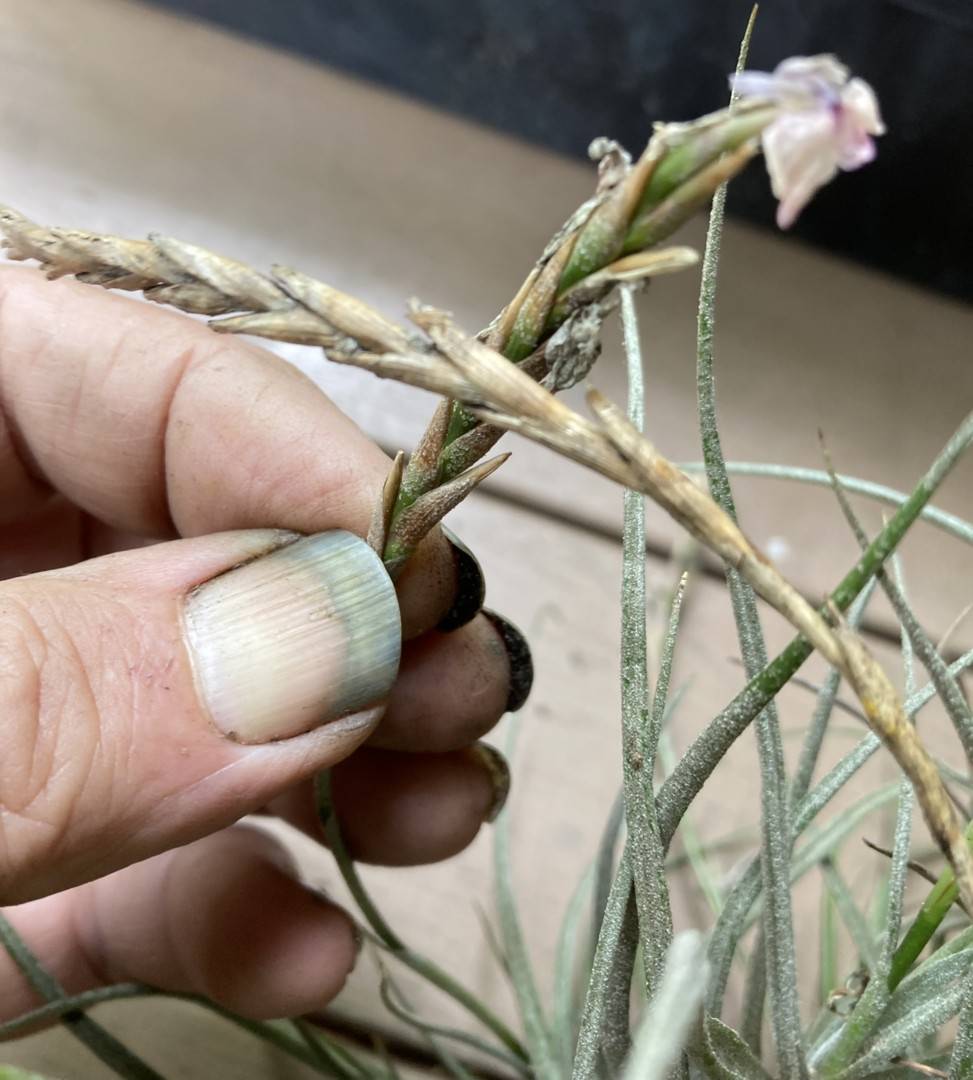
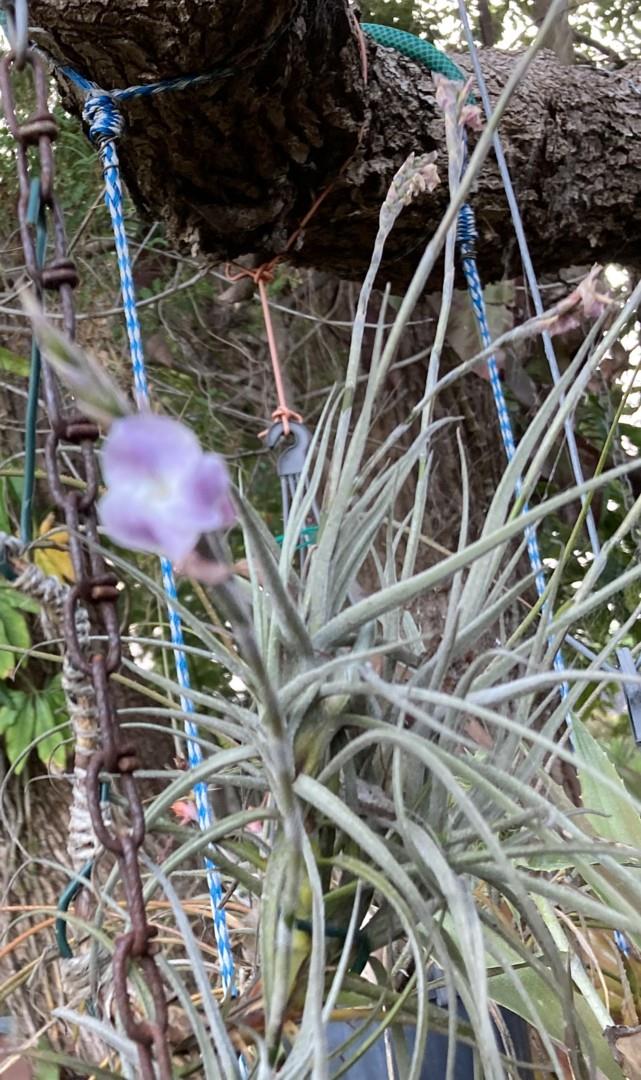
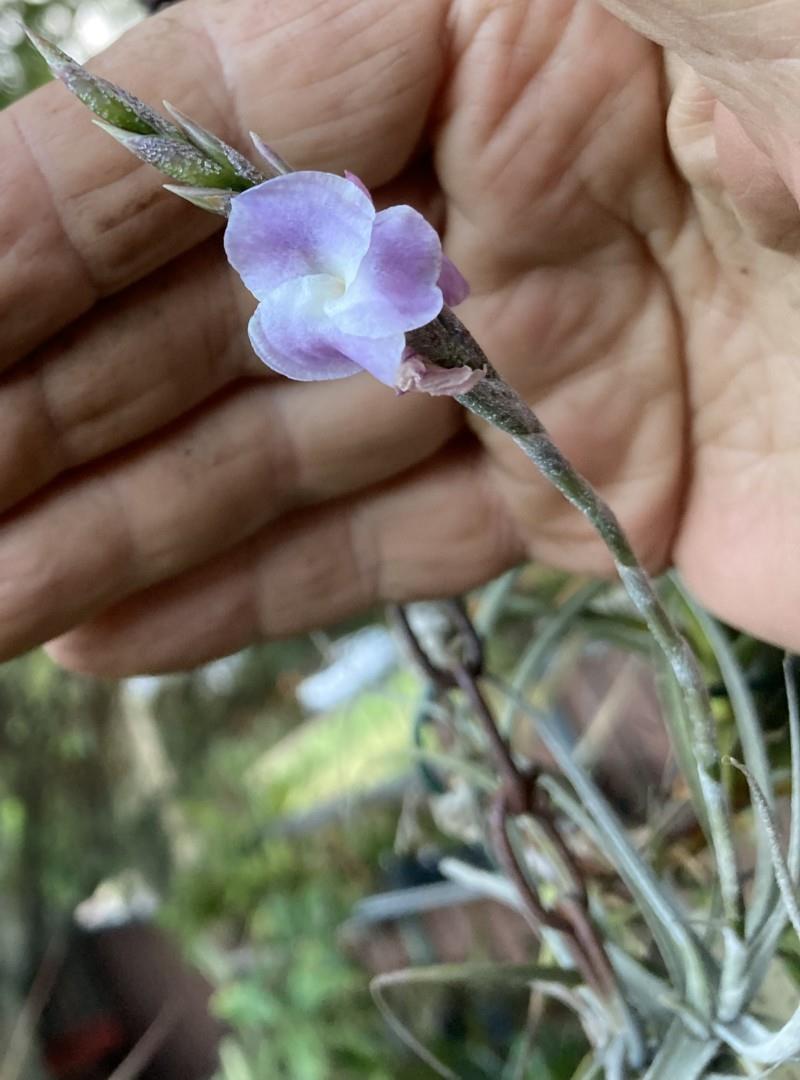
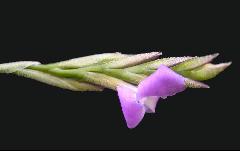
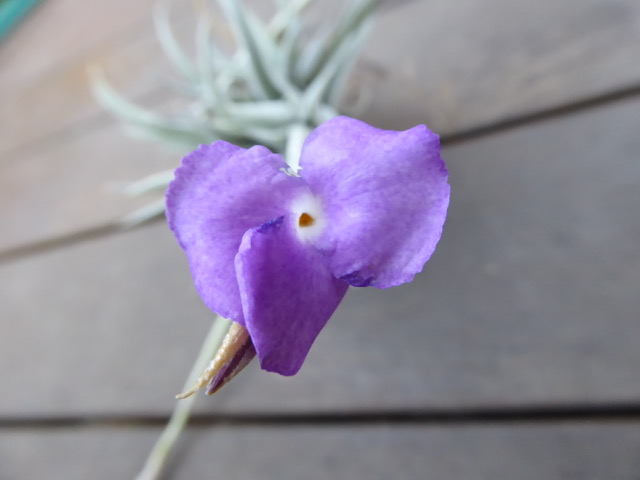
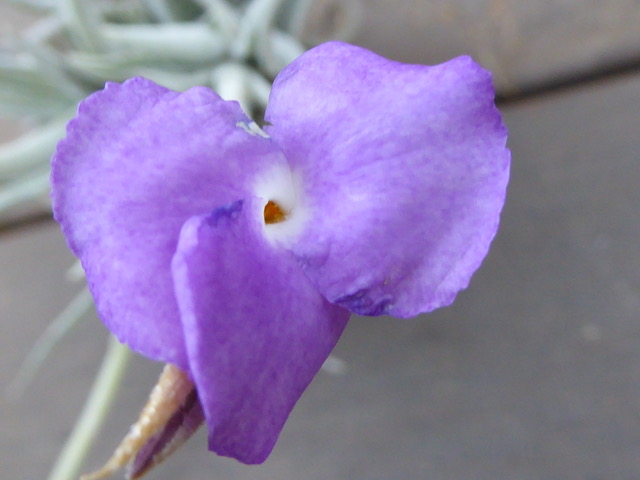
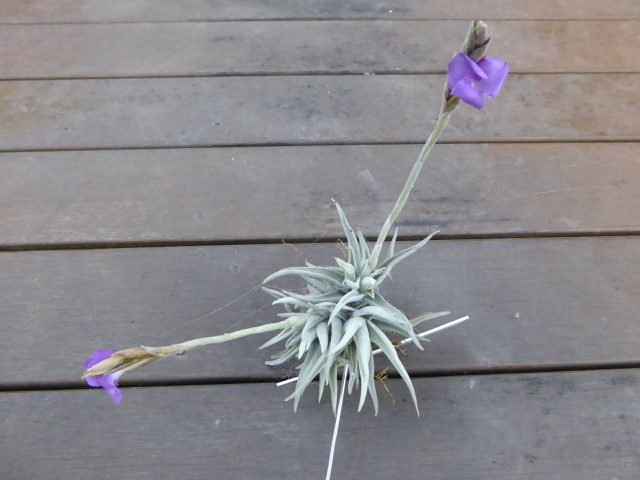
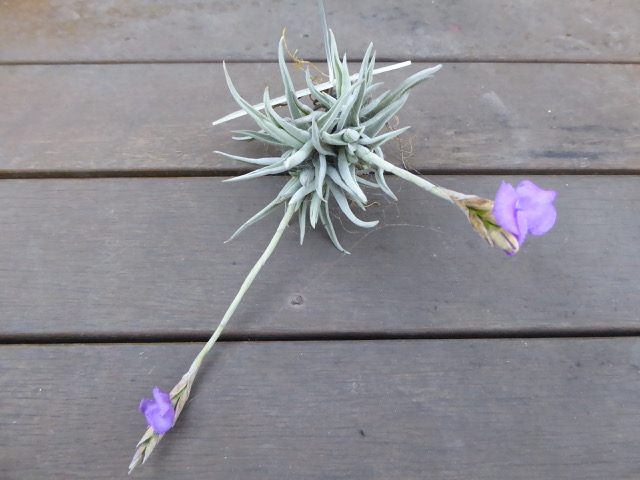
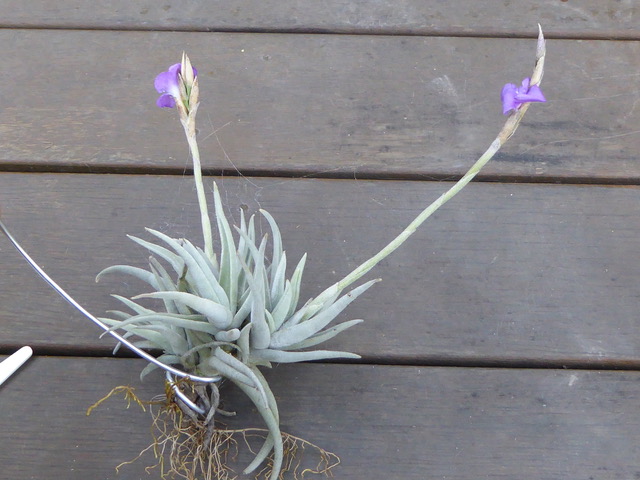
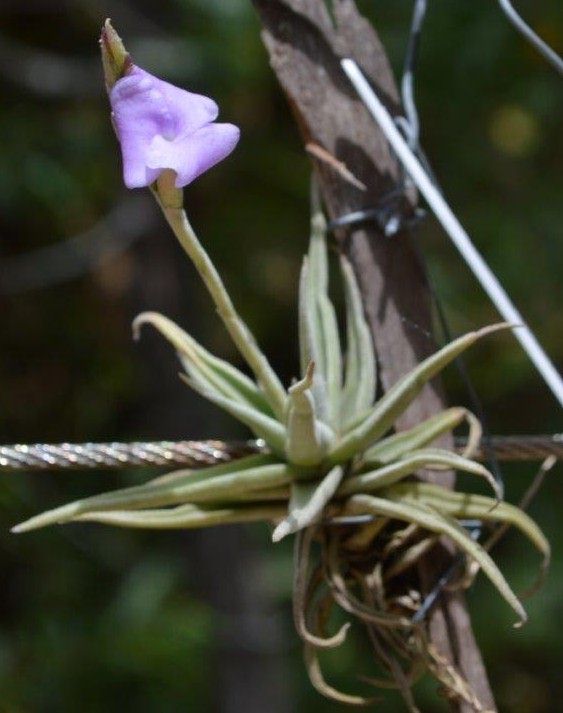
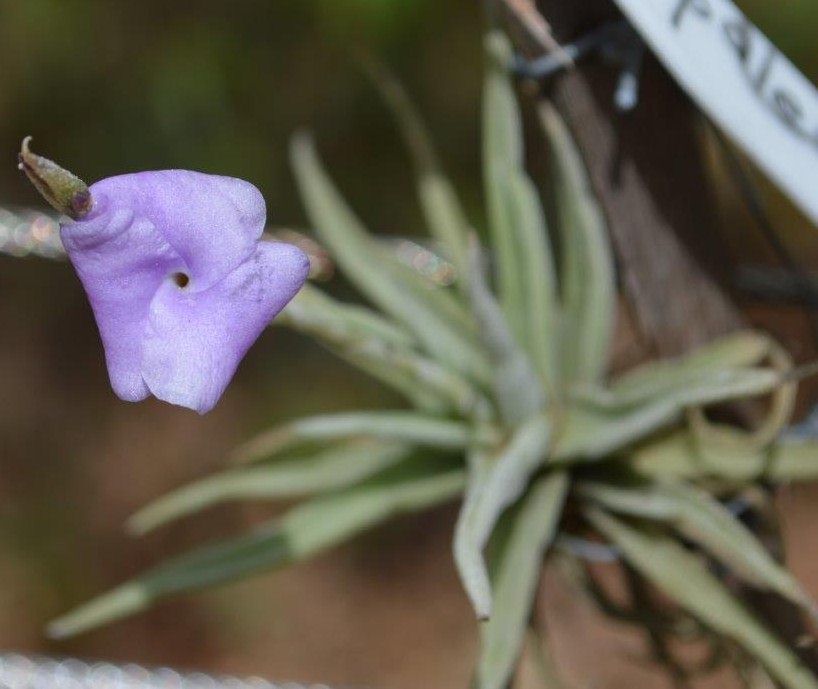
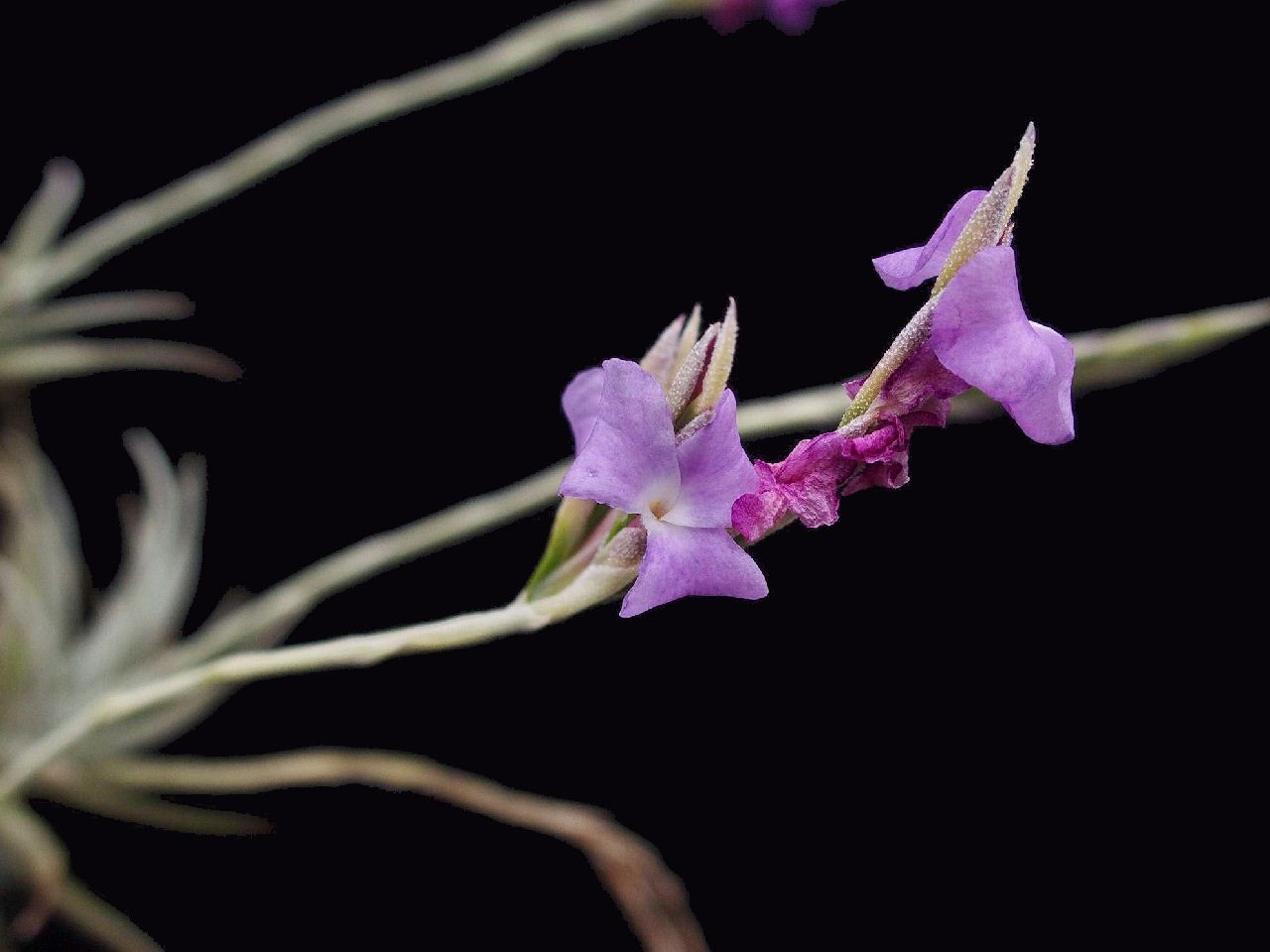
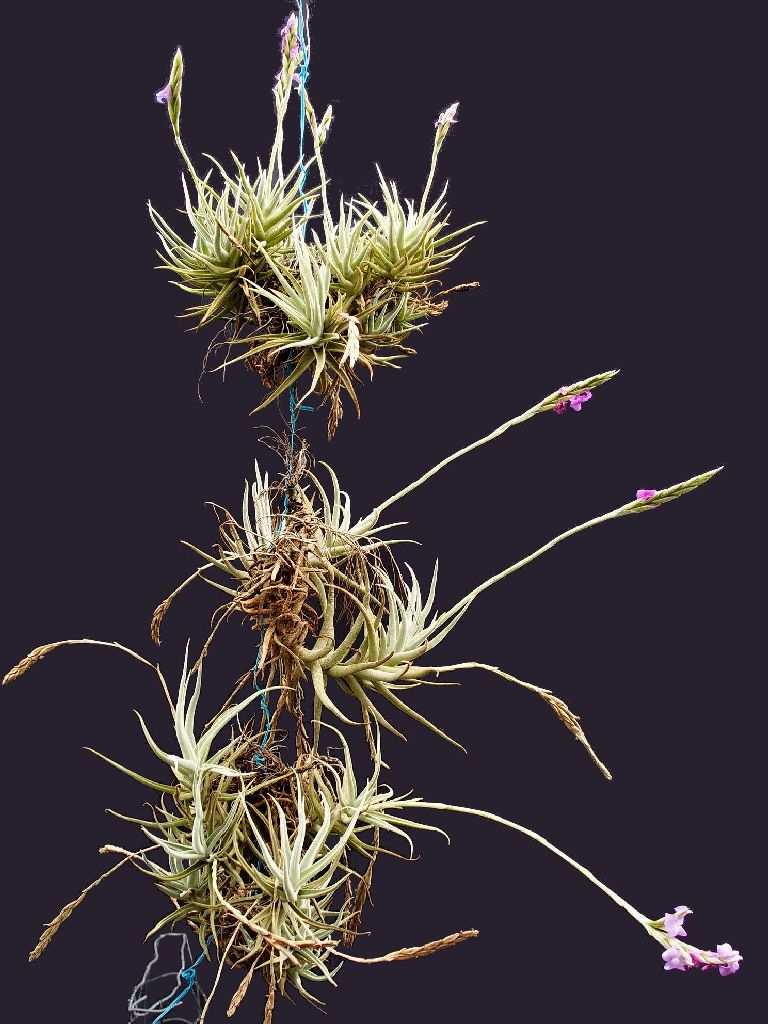
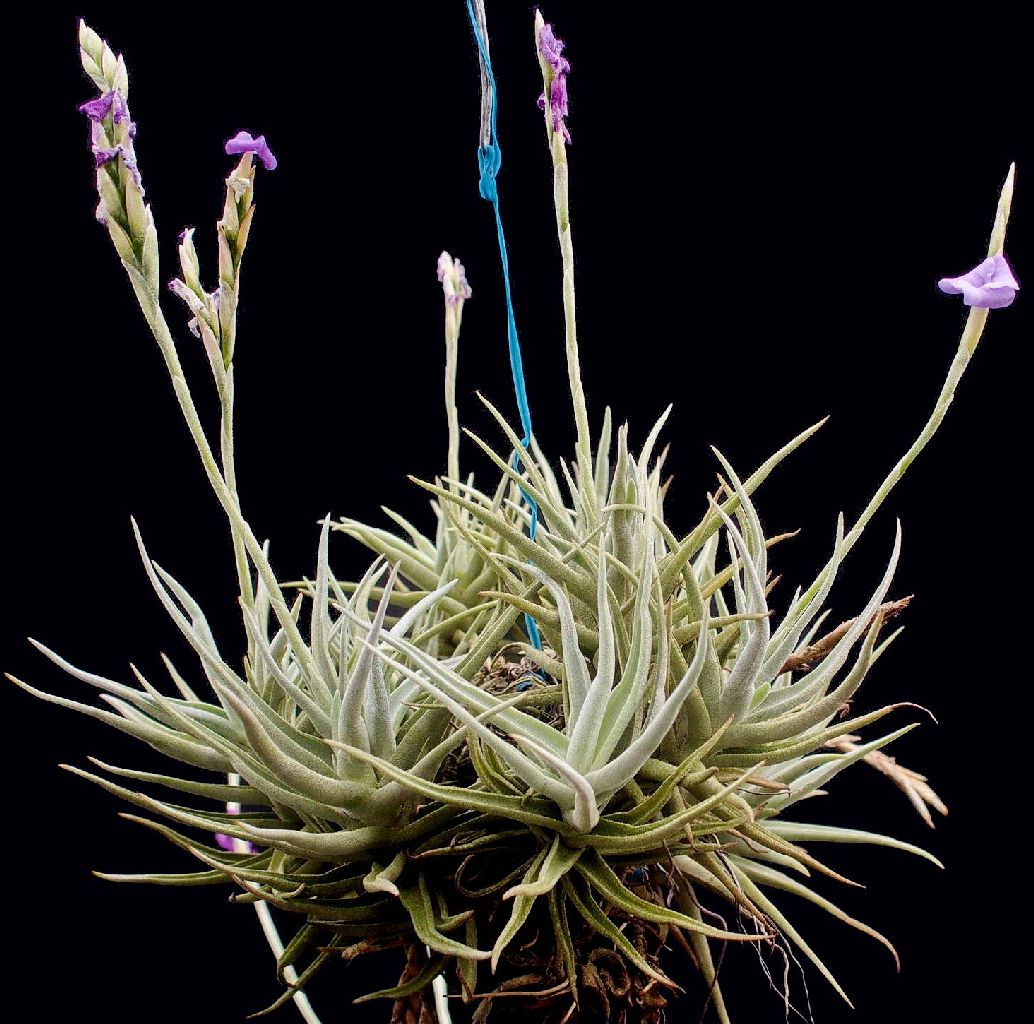
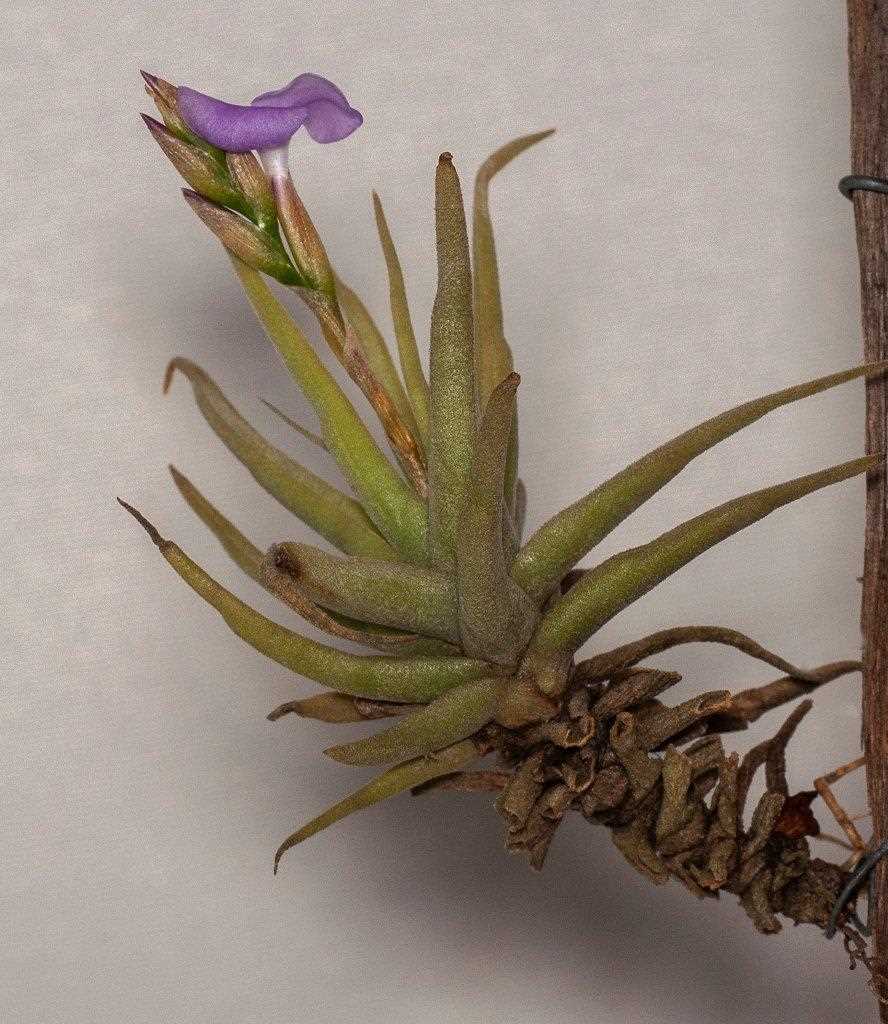
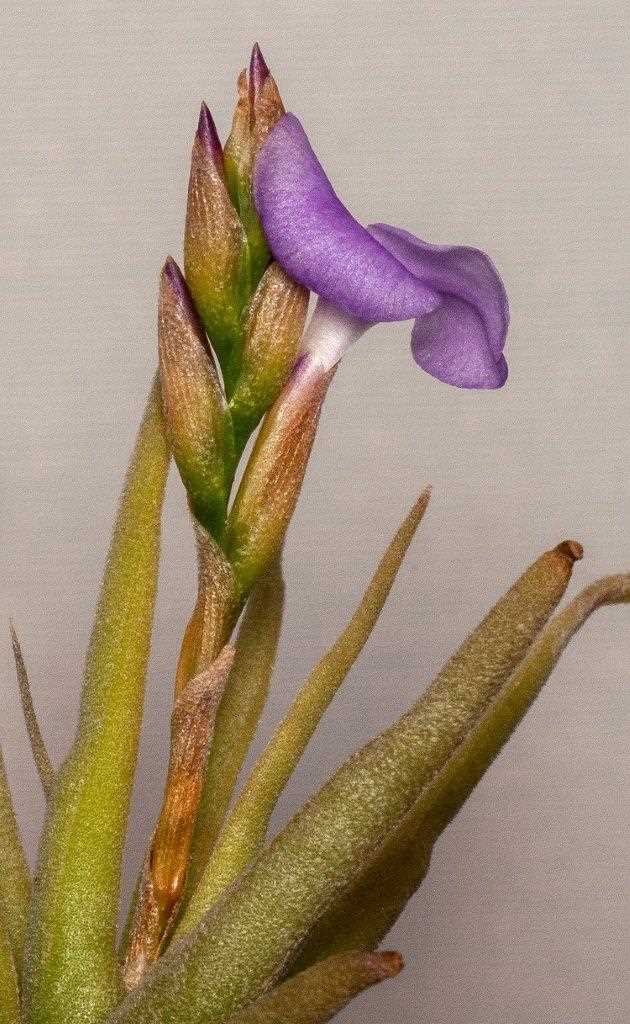
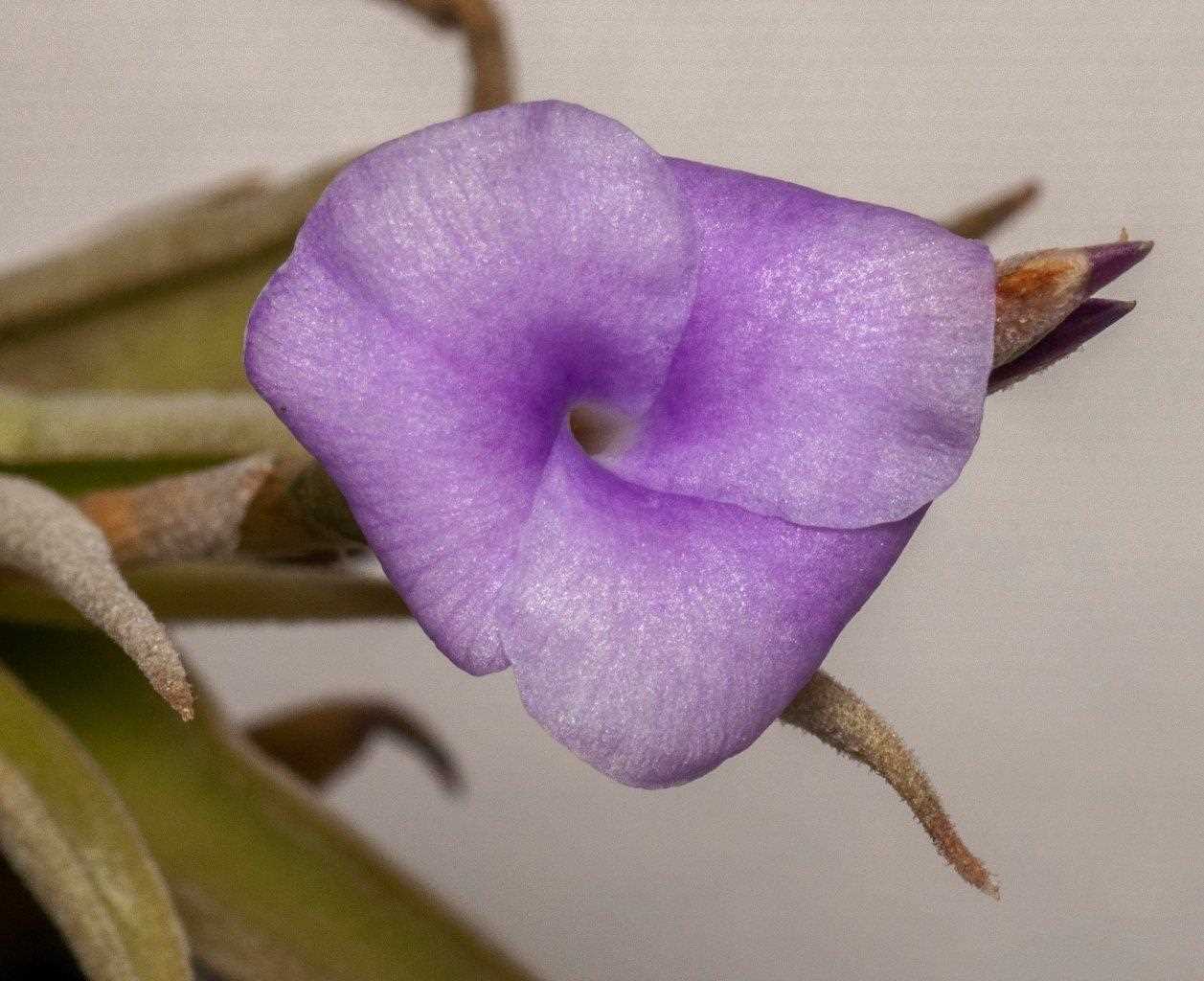
Tillandsia paleacea Presl subsp. apurimacensis W. Till JBS 1993 p7-10
A subspecie typica caule breviori cum internodiis multo brevioribus, foliis rectioribus et indumento appresso recedit.
Typus: Peru, Depto. Apurimac, Prov. Abancay, km 87 in via de Chalhuanca a Abancay, 30 km ante Abancay, 1840 m.s.m., 12. 8. 1982, leg. W Till & E. & F. Vitek WT183, epilithica in rupibus fere verticalibus (holotypus: WU, isotypi: USM, WU); Depto. Apurimac, Prov. Abancay, Hac. Casinchihua in valle fluminis Rio Pachachaca, 33 km (per aerem) SWab Abancay, 2300-2500 m.s.m., 21.12.1962, leg. H.H. & C.M. lltis & D. & V Ugent 826a (paratypus: K).
Plants moderately stemmed (5-12 cm), without or only with dead leaves in the older (basal) part, with strong, woody, adhesive roots, internodes very short and wholly concealed by the leaves.
Leaves densely polystichous, narrowly triangular, ( 4-) 6-10 cm long, densely appressed lepidote, slightly succulent, more or less flat but the margins rolled up and hence semicircular in cross section, evenly tapering to a subulate apex.
Inflorescence scape well developed, 10-13 cm long, concealed by lanceolate
Scape bracts, these abaxially densely lepidote and slightly longer than the internodes; Inflorescence simple or very rarely with a reduced lateral branch.
Flowers c. 2 mm very stout pedicelate, without fragrance.
Floral bracts 10-14 ( -16) mm long, c. 3 mm wide, broadly linear, acute, densely to moderately lepidote, ecarinate, nerved towards apex when dry, stramineous.
Sepals elliptic-lanceolate, obtuse, glabrous, 10-12 mm long, c. 4.5 mm wide, usually about equalling the floral bracts, subfree (c. 0.5-0.7 mm equally connate), ecarinate.
Petals c. 19 mm long, the blade purplish blue, rhombic-cuneate with undulate-crenate upper margin, c. 9 mm long and c. 8.5 mm wide, the claw white, linear, c. 10 mm long and c. 2 mm wide.
Stamens 6 mm long, exceeding the ovary but deeply included into the throat of the flower, the anthers orange, cylindric, c. 2 x 0.5 mm, the filaments white, broadly linear and 0.5 mm wide, flat, rather abruptly contracted into a subulate apex, basally attached to the anthers.
Ovary cylindric, c. 3 x 1.5 mm, style very short and stout, stigma lobes simple-erect. Fruit unknown.
The plants are named after the province, Apurimac.
Distribution: Typical plants are found in the lower valley of the Rio Pachachaca. Similar plants have also been collected in Prov. Ayachucho near Huanta at 2300 m elevation (0. Irnstorfer 33a, WU), in Prov. Huancavelica near Mayocc in the valley of the Rio Mantaro at 2200 m elevation (H. & L. Hromadnik 2036, WU), and in Prov. Cuzco, valley of the Rio Urubamba (R. & K. Ehlers P8103, WU). They all differ in rosette width; the floral bract covering varies from more or less lepidote to glabrous.
"Sixteen kilometers farther up in the same valley the second population was found under the same ecological conditions. The peculiarity was that within one and the same population the leaves were arranged polystichously and distichously, with all transitions. Some of the distichously leafed plants were in flower."
Tillandsia paleacea subsp. apurimacensis f. disticha W. Till,
A forma typica foliis distichis et foliorum marginibus magis involutis differt.
Typos: Peru, Depto. Apurimac, Prov. Abancay, in via inter urbes Chalhuanca et Abancay, circiter 46 km ante Abancay, 2000 m.s.m., 12. 8. 1982, leg. W Till & E. & F. Vitek WT182, epilithica in rupibus fere verticalibus (holo- et isotypus: WU).
Leaves distichously arranged, slightly more succulent than in the typical form and the margins of the leaves more involute.
Tillandsia paleacea is closely related to T. streptocarpa Baker as stated in Smith & Downs (1977) and in Rauh (1987).
Those species can be separated mainly by a combination of characters:
T. paleacea:
long stems,
leaves shorter than the stem,
inflorescence mostly simple,
floral bracts mostly lepidote.
T. streptocarpa:
stems very short,
leaves longer than the stem,
inflorescence mostly digitately compound,
floral bracts mostly glabrous or subglabrous.
Simple inflorescences are not very rare in T. streptocarpa and the floral bracts can also be rather densely lepidote. Those facts stress the close affinity of both. The new subspecies resembles T. paleacea in its inflorescence morphology, in its vegetative morphology, however, it comes nearer to T. streptocarpa and seems to link both species.
Detail from Baker 1889
11. T. FUSCA Baker in Journ. Bot.1878, 240.
Leafy stem stout, woody, ½ ft. long, copiously branched.
Leaves laxly disposed, subterete, 1½-2 in. long, 1/12 – 1/8 in. broad low down, subcoriaceous, channelled down the face, densely clothed all over with ovate acute lepidote scales.
Peduncle very short, densely 2-3-flowered;
flower-bracts oblong-lanceolate, lepidote, ½ in. long.
Sepals rigid, naked, lanceolate, ? in. long.
Petals and capsule not seen.
Hab. Andes of Peru; Obragilla, Brackenridge !
27. T. SCHENKIANA Wittm, in Engl. Jahrb. xi 63.
Leaves spaced out over a 2-3-inch stem, subulate, ascending, 9-10 in. long, 1/8 – 1/6 in. broad low down, densely clothed with lax deflexed linear whitish scales.
Peduncle slender, ½ ft. long;
bract-leaves long pointed.
Spike dense, simple, distichous, an inch long, ?-½ in. diam.;
flower-bracts oblong-lanceolate, ½ in. long.
Calyx a little overtopping the flower-bract.
Petal-blade small, suborbicular, purplish.
Hab. Andes of Columbia; Tolima, alt. 3000 ft., Lehmann 2234! Near T. scalarifolia.
28. SCALARIFOLIA Baker in Journ. Bot. 1887, 235.-
Leaves spaced out over a stem 2-3 in. long, all except the upper spreading, subulate from the base, rigidly coriaceous, 3-4 in. long, densely persistently lepidote.
Peduncle slender, 2-3 in. long;
bract-leaves few, with short free points.
Inflorescence a dense simple spike 1-1½ in. long, ¼-?in. diam.;
flower-bracts oblong -lanceolate, lepidote, ½ in. long.
Calyx reaching to the tip of the bract.
Petal-blade obovate-cuneate, purple, ¼ in. long.
Stamens not longer than the calyx.
Hab. Andes of Bolivia, Pentland !
30. T. CHILENSIS Baker.
Leafy stem 3 in. long.
Leaves laxly disposed, linear, spreading, 2-3 in. long, ¼-? in. broad low down, densely laxly lepidote all over.
Peduncle 4-5 in. long.
Inflorescence a dense simple distichous spike 1½-2 in. long, ¼ in. broad;
flower-bracts oblong, ? - ½ in. long.
Calyx as long as the flower bract.
Petals reddish, obovate, ¼ in. long and broad.
Stamens not longer than the calyx.
Hab. Andes of North Chili, C. Gay ! (Herb. Mus. Par.).
Detail from Mez 1935
357. T. favillosa Mez in Fedde, Repert. III. (1906) 43. –
Elongate caulescens, usque ad 0,25 m longa mihi visa. Folia fere distiche ordinata, squarrose patentia, ad 0,11 m longa, tota longitudine involuta, subulata, persensim acutissima, lepidibus cinereis piliformibus plumose villosa. Scapus gracillimus, erectus, folia fere duplo superans, vaginis tubulosis, acutis, dense lepidotis, demum nonnunquam glabratis, internodia paullo superantibus indutus. Inflorescentia simplicissima, disticha, ad 8-flora, usque ad 40 mm longa et 7 mm lata, flabellata, anguste lanceolata, utrinque acuta; bracteis stricte erectis, flores involventibus, ovatis, acutis, venoso-lineatis, ad 13 mm longis, dense lepidotis, sepala subaequantibus vel inferioribus paullo superantibus. Flores stricte erecti, ad 20 mm longi; sepalis subaequaliter liberis, coriaceis, glabris laevibusque, late lanceolatis, acutis, ad 17,5 mm longis. Petala laminis latissimis, patentibus, suborbicularibus, rotundatis. Stamina profunde inclusa, stylum superantia.
Peru: Dept. Cuzco, Prov. Urubamba, bei Ollantaitambo (Weberbauer n. 4933).
358. T. lanata Mez in Bull. Herb. Boiss. 2. ser. V. (1905) 109.
Longe caulescens, usque ad 0,4 m longa mihi visa. Folia quaquaverse ordinata, patentia vel recurvata saepius irregulariter crispata, fere tota canaliculatim subteretia, ad 75 mm longa, basi vix ultra 6 mm lata, lepidibus maximis crasse lanata. Scapus gracilis, erectus, folia bene superans, vaginis inferioribus breviter laminatis superioribus acutis, his quam internodia brevioribus, lepidotis indutus. Inflorescentia simplicissima, distiche flabellata, usque ad 8-flora, anguste lanceolata, utrinque acuta, usque ad 45 mm longa et (floribus neglectis) 6 mm lata; bracteis inferioribus saltem lepidotis sepala aequantibus vel iis paullo brevioribus, elliptico-triangularibus, acutis, prominenti-venosis, ad 12 mm longis. Flores stricte erecti, ad 17 mm longi; sepalis subaequaliter liberis, glaberrimis, laevibus, rigide coriaceis, ellipticis, subrotundatis, ad 10 mm longis. Petala laminis violaceis, latissime obovatis, optime patentibus, latissime rotundatis. Stamina profunde inclusa, stylum superantia.
Peru: bei Matucana (Weberbauer n. 1697)
20. T. Schenckiana Wittm. n. sp., Bot. Jahrb. 11: 63. 1889.
caule brevi; foliis ca. 20, sparsis, horizontaliter patentibus (exsiccatione erectis) elongatis, e basi late vaginata, alba, nuda lineari-subulatis; superne setaceis, canaliculatis, patenti-argenteo-lepidotis, scapo erecto, foliis breviore; anaphyllis inferioribus foliaceis, superne setaceis, superioribus ad vaginas breviter acutatas, fere glabras reductis; spica simplici, brevi, 6-7florae; bracteis erectis; lanceolatis, acutis, glabris, striatis, calycem arcte involventibus; sepalis bracteis 1¼ longioribus, lanceolatis, pergamaceis, arcte involutis; petalis basi in tubum convolutis, lamina valde patente, orbiculari,.ungue anguste lineari. Staminibus calyce brevioribus, stylo brevissimo, stigmatibus capitatis.
Radix fibrosa, brevis, caulis brevis, superne vaginis albis foliorum vetustorum obtectus. Folia haud rosulata, viridi-glauca, 10-28 cm. longa, setacea, insigniter modo lepidota, lepidiis in pila patentis vel deflexa elongata attenuatis. Scapus 14-15 cm longus. Spica dense disticha, 3,5 cm longa, 1 cm late; bracteae florales 1 cm, calyx 1.2 cm longus; petalorum ungula 1,2 cm, lamina 1 cm longs, 9 mm lata, violacea. Filamenta gracillima, antherae breviter-lineares. Ovarium, triangulata-conicum, stylo subnullo.
Columbia, Tolima.
Frequentissima; ad arbores ad flumina et in silvis parvis dictis “Savannae” prope, La Plata, alt. 4000 m (no. XXVII et 2234) 10. Dec. 1882, statu florifero
Intermedia inter T. tricholepim Bak. Brasiliae meridionalis et T. scalarifoliam Bak. Andium Boliviensium. A prima differt caule subelongato, foliis.sparsis, floribus plurimis, laminis petalorum violaceis, nec fulgide rubris, minoribus; ab altera foliis lepidibus piliformibus, scapo breviore, bracteis; minoribus, minus striatis, lamina petalorum orbiculari, ab utrisque foliis multo longioribus: .
Nominavi in honorem cl. Dr. H. Schenck, qui in Bromeliaceis in regionibus tropicis cognoscendis multum desudavit.
Tillandsia paleacea Presl, Rel. Haenk. 1: 125. 1827
T. foliis densissime argenteo - paleaceis lineari - subulatis canaliculatis reflexis, spica simplici pauciflora contracta, bracteis glabriusculis calycis longitudine.
Hab. in Chile, Perennial
Caulis semipedalis adscendens ramosus vaginis foliorum imbricatis obtectus. Folia 30 lineas longa, basi duas lata, horizontaliter patentia, lineari - subulata canaliculata, apice in tenue acumen attenuata et recurvata, undique vaginisque squamis argenteis lanceolatis paleaeformibus patentibus densissime obtecta. Pedunculus bipollicares erectus vaginis striatis acutis imbricatis squamoso-paleaceis obtectus. Spica pollicaris oblonga quadriflora, floribus imbricatis. Bracteae ovato-oblongae acutiusculae striatae squamis rotundatis argenteis adspersae ultra 4 lineas longae, superiores calvescentes. Calyx glaber longitudine bracteae, laciniis oblongo-lanceolatis obtusiusculis. Nec corollam nec capsulam vidi.